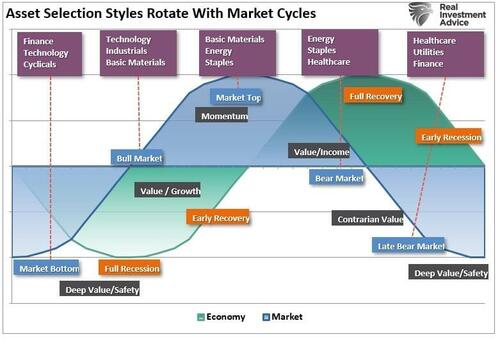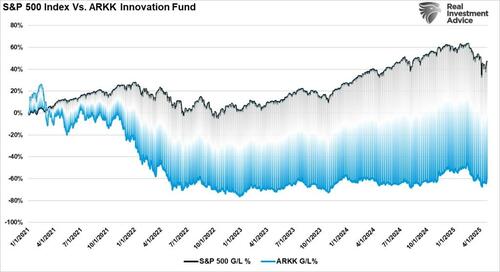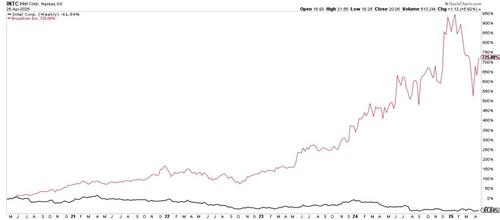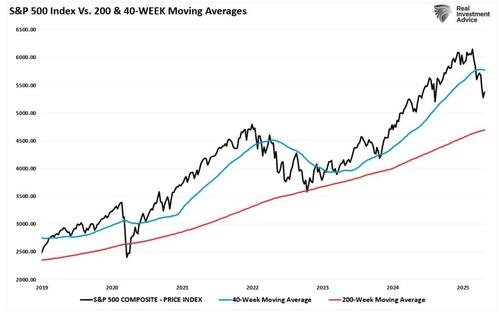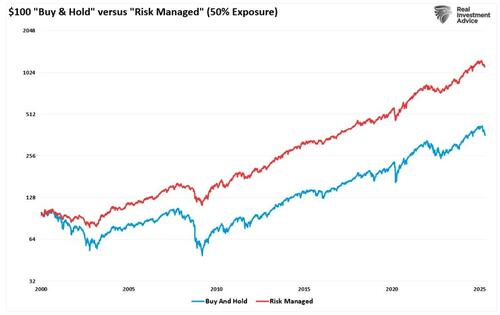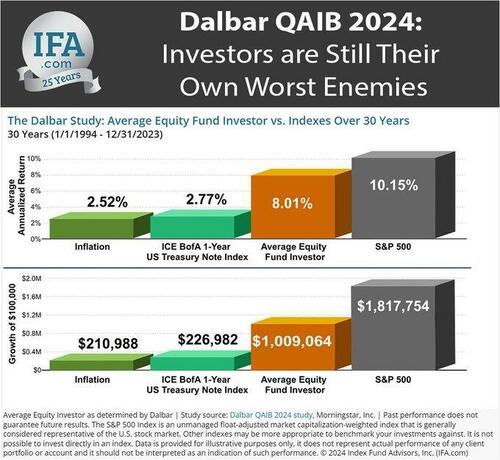Authored by Lance Roberts via RealInvestmentAdvice.com,
In investing, success is often judged by numbers – returns on investment, percentage gains, and the ability to outperform benchmarks like the S&P 500.
However, some investors frequently pursue a peculiar set of “awards” without realizing the pitfalls they embody. These unspoken goals, while tempting, rarely lead to sustainable investment success. If there were awards for some of these common but ill-advised behaviors, they would likely cause more harm than good. Here are some of the “investing awards” you’ll never receive, because chasing them isn’t worth the cost.
I Never Sold At A Loss Medal
Market volatility is an inherent aspect of investing. Striving to avoid all losses, or drawdowns, is unrealistic. Trying to sidestep volatility often leads to lower returns and missed growth opportunities. Overly conservative investments may not keep pace with inflation, steadily eroding purchasing power. Managing risk effectively instead of avoiding it is essential for long-term portfolio success.
Many investors pride themselves on never realizing a loss, believing that holding every position until it turns profitable is a badge of honor. However, this mindset often leads to holding onto poor performers indefinitely, tying up capital that could be better deployed elsewhere. This behavior is a classic example of behavioral mistakes investors make, specifically the “disposition effect,” where investors hold losing assets too long while selling winners too early. Focusing solely on avoiding losses often damages overall portfolio returns.
Like everything in life, there is a “season” and a “cycle.” When it comes to the markets, “seasons” are dictated by the “technical and economic constructs,” and the “cycles” are dictated by “valuations.” The seasons are shown in the chart below.
As such, successful investing requires disciplined pruning to maintain a healthy garden. Recognizing when an investment no longer aligns with your strategy and cutting losses early frees up capital for better opportunities. There is no award for stubbornly holding a stock that continues to drag down your portfolio.
I Took On As Much Risk As I Could Award
During bull markets, taking on excessive risk seems attractive. High-risk assets like speculative tech stocks or cryptocurrencies often deliver eye-catching gains. Some investors view risk-taking as bravery. But the reality is that high risk doesn’t guarantee higher returns; it is frequently quite the opposite. As Howard Marks previously discussed, risk and volatility aren’t the same thing. For years, many investors (and academics) have been taught that volatility, the ups and downs of stock prices, equals risk. However, volatility is just one part of the picture, but risk is the probability of losing money. Just because prices bounce around doesn’t mean you’re at risk of a loss.
However, “High risk equals high reward” is not always true. Just because an investment has a higher degree of risk does not guarantee it will deliver superior returns. Given that risk is the probability of losing money, taking on excess risk does increase the potential for poor returns over time. In other words, increasing risk increases the potential for significant losses. As such, investors must be careful about chasing returns without fully understanding the risks. The goal should be to weigh the possible outcomes and ensure the potential reward is worth the risk taken.
A good example was in 2022, when retail investors chasing meme stocks, SPACs, and IPOs suffered significantly heavier losses than the index. At that time, the ARK Innovation Fund, managed by Cathy Wood, was an example of peak speculation in the market. However, since then, those investments failed to recover. In other words, speculative risk-taking did not lead to outsized returns.
Sustainable investing requires aligning investments with financial goals and risk tolerance to avoid exposing one’s future to unnecessary volatility. Diversification, not reckless risk-taking, remains the best tool for improving risk-adjusted returns. While speculative investments lack the excitement and thrill, prudent investors build strategies focused on taking calculated, strategic risks that contribute to long-term wealth.
“You don’t get rewarded for taking risk; you get rewarded for buying cheap assets. And if the assets you bought got pushed up in price simply because they were risky, then you are not going to be rewarded for taking a risk; you are going to be punished for it.” – Jeremy Grantham
Successful investors avoid “risk” at all costs, even if it means underperforming in the short term. The reason is that while the media and Wall Street have you focused on chasing market returns in the short term, ultimately, the excess “risk” built into your portfolio will lead to inferior long-term returns. Wile E. Coyote never received an award for chasing the Roadrunner over the cliff.
I’m a Long-Term Investor (Only When I’m Losing Money) Certificate
A common rationalization is to claim to be a long-term investor only when losses mount. When an investment underperforms, investors often tell themselves they are simply “staying the course,” using time to justify inaction. Research by Barberis and Thaler (2003) on behavioral biases shows that loss aversion—the tendency to prefer avoiding losses over acquiring gains—strongly influences this behavior.
True long-term investing demands more than patience; it requires a disciplined, objective framework. This means purchasing quality assets with strong fundamentals, establishing clear investment theses, and periodically reassessing those theses. Successful investors, like Warren Buffett, have emphasized that staying invested in a poorly performing asset without reevaluating it is not long-term investing—it is emotional decision-making disguised as strategy.
A good example is Intel (INTC) versus Texas Instruments. Over the last five years, Intel has lost 62% of its value as it lost its chip-making dominance to companies like AMD, Nvidia, Broadcom, and others. For investors holding Intel, many are hoping that something will occur and they can recover that loss. However, at any point over the last 5 years, they could have sold Intel and bought virtually any other chip maker and increased their wealth. While there are many examples, this exemplifies the point of opportunity cost. Holding a losing asset for long periods eats away at the wealth-building process and consumes our most precious commodity: time.
Building a resilient portfolio is not about loyalty to individual positions. It is about effective asset allocation, risk management, and ongoing evaluation. Markets evolve, industries change, and even once-promising companies can lose their competitive edge. Recognizing when an investment no longer fits your portfolio’s long-term goals—and having the discipline to move on—is a hallmark of professional investing, not a weakness.
I Never Used Stop-Losses Or Managed Risk Ribbon
Some investors view risk management strategies like stop-losses, portfolio rebalancing, and diversification as unnecessary restraints on potential gains. Instead, they trust intuition, believing they can “ride out” volatility. Behavioral research (Shefrin, 2000) shows that overconfidence is one of individual investors’ most common mistakes, often leading to catastrophic losses when market conditions change suddenly.
Managing risk effectively isn’t about fear or pessimism. It is about protecting your capital from irreparable damage so that you can continue participating in future market growth. Stop-losses are designed not to predict downturns but to limit exposure to individual positions that deteriorate beyond acceptable thresholds. Similarly, rebalancing prevents portfolios from drifting into unintended risk concentrations over time.
An example of risk management can be very simplistic. For example, using a 40-week moving average as a “risk off” indicator can help avoid more protracted market drawdowns.
We can apply a “risk management” strategy to that moving average to reduce risk during corrective periods. For this example, when the S&P 500 breaks below the 40-week moving average, stock exposure is reduced by 50%, and it reverses to 100% when the index crosses above that moving average. The results are shown below.
While there are times when investors were triggered to reduce and then increase exposures quickly, the 2000 and 2008 financial crises underscored the consequences of unmanaged portfolios. Many investors holding full exposures to equities without risk controls suffered permanent losses (Brunnermeier, 2009). Risk management is the bridge between surviving market turbulence and thriving in long-term wealth creation. No one ever received an award for riding markets substantially lower. Such is not a testament to resilience—it is an avoidable failure.
I Beat the S&P 500 Medallion
Outperforming the S&P 500 is often portrayed as the ultimate measure of investing success. However, data from the SPIVA U.S. Scorecard shows that approximately 85% of actively managed U.S. equity funds underperform their benchmarks over ten years. While not every manager underperforms yearly, and periods of outperformance exist, the persistent challenge highlights the difficulty of consistently beating the S&P 500.
Pursuing benchmark-beating returns can lead investors into dangerous territory. Studies in behavioral finance (Statman, 2000) show that investors chasing outperformance often engage in high-turnover strategies, excessive trading, and speculative bets. These behaviors introduce additional risks and higher transaction costs that erode potential gains. The result is that investors, while trying to “beat the index, ” consistently underperform over time. As noted in the 2024 Dalbar Research report:
As noted above, even the most simplistic of risk management strategies can improve returns over time while maintaining a focus on investment goals. Instead of fixating on beating the benchmark, focus on building a portfolio that aligns with your financial goals and personal risk tolerance. Ultimately, true investing success isn’t measured against a broad index. No one will ever give you an award for beating an index from one year to the next. However, they will measure your success by what matters most: whether you achieved your objectives, like securing a comfortable retirement or funding important goals.
Conclusion: Building a Smarter Path to Investing Success
To avoid the costly mistakes outlined above, investors must adopt a disciplined, process-driven approach to managing their portfolios. Sustainable investment success comes from understanding, not reacting to, market behavior. Here are the critical steps you should take:
-
First, embrace losses as part of the investment journey. Prune weak investments when they no longer fit your strategy, reallocating capital to stronger opportunities rather than waiting for recoveries that may never come.
-
Second, respect risk. Avoid equating bravery with excessive risk-taking. Build portfolios aligned with your personal financial goals and loss tolerance, focusing on diversification and asset valuation rather than speculative bets.
-
Third, redefine long-term investing. Remaining loyal to a poor investment out of hope wastes time and wealth. Maintain objectivity by reassessing whether each holding still meets your original investment thesis.
-
Fourth, implement active risk management. Use stop-loss strategies, periodic rebalancing, and technical indicators like the 40-week moving average to protect against significant drawdowns. Managing risk is about ensuring survival, not limiting success.
-
Finally, stop chasing the S&P 500. Focus instead on achieving your financial objectives with consistent, risk-adjusted returns. Outperformance is meaningless if you fail to meet real-world needs, like securing retirement income or building generational wealth.
Successful investing is not about winning arbitrary “awards.” It is about managing risk, preserving capital, and steadily compounding returns toward your goals. Ignore the noise, stay disciplined, and remember: no one hands out awards for reckless investing—only consequences.
Loading…



